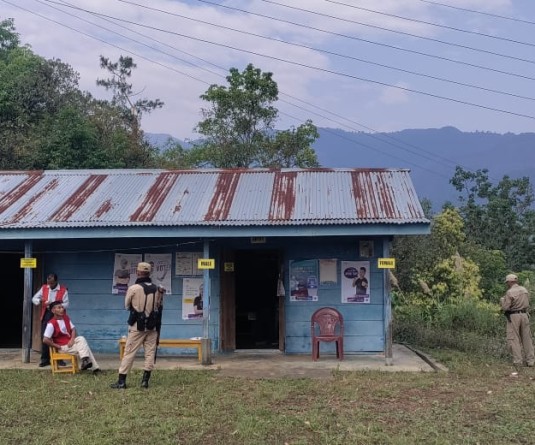
Dimapur, November 22 (MExN): On the occasion of the 4th anniversary of “Naga Unification”, the GPRN/NSCN stated it has chosen to “rise above factionalism for the sake of future Naga generations.” Hevukhu Yeptho, Speaker, National Tatar Hoho, GPRN/NSCN in his address said that, “on November 22, 2007, we committed ourselves; we took it as our bounden duty and sought unification of warring Naga brothers particularly the National workers from NSCN (K) and NSCN (IM).” He said that this day is “a special occasion for all those who believe in Naga unity. “
Giving a brief account of the “Naga Unification,” he said that when the idea of Naga unification was mooted at the insistence of Naga people led Naga frontal Leaders and civil societies in the years preceding 2007, senior national workers from various political groups began to communicate with each other and began preparing ground works in consultation with Collective Leadership of both NSCN (K) and NSCN (IM). He said that from time to time, various tribal Hohos facilitated the Kilonser level meetings at different venues despite unabated fratricidal killings; adding that when the Nagas desired and appealed for unity among national workers, who are they to go against the wishes of the people.
Further, he said that in early 2007, “Collective Leadership of both NSCN (K) and NSCN (IM) affirmed their support for Naga unification move and therefore senior national workers from both the groups earnestly believed that finally Naga unification was at hand.”
Unfortunately, he added, “despite the assurances given to frontal leaders including the NBCC, few leaders at Hebron Camp remained non-commital and began to misinterpret the hard work of senior national workers.
The translating of words into action never happened. Courage and decisiveness was needed at that very hour however, scepticism and apprehension clearly dictated their hearts and this was not a good sign for the Naga people yearning for unity.”
He also said that on November 21, 2007, the overwhelming number of National workers from both groups from NSCN (K) and NSCN (IM), in consultation with Naga frontal Organisations and in the interest of the Naga people, decided to bring the change themselves. He said, “There was no coercion, threat or intimidation against anyone. It was simply a choice for the national workers to choose whether they were for unity of the Nagas or against it. On November 22, 2007 at Hovukhu Village in Niuland, UT I, it was declared that Naga unification was firm and there was no stopping it. “
He further reflected on the four years gone by since, saying that “today we are proud of the fact that many positive steps have been taken by the Naga people and political groups.” He acknowledged the emergence of FNR as the torchbearer of Naga Reconciliation and added that the Chiangmai meetings; the highest level meetings in 2010 and 2011; the cessation of hostilities among the Naga groups are etc. are all remarkable achievements. “GPRN/NSCN does not take the credit for these positive steps but perhaps November 22, 2007 practically sowed the seed of understanding among the Naga political groups,” he said.
Giving a brief account of the “Naga Unification,” he said that when the idea of Naga unification was mooted at the insistence of Naga people led Naga frontal Leaders and civil societies in the years preceding 2007, senior national workers from various political groups began to communicate with each other and began preparing ground works in consultation with Collective Leadership of both NSCN (K) and NSCN (IM). He said that from time to time, various tribal Hohos facilitated the Kilonser level meetings at different venues despite unabated fratricidal killings; adding that when the Nagas desired and appealed for unity among national workers, who are they to go against the wishes of the people.
Further, he said that in early 2007, “Collective Leadership of both NSCN (K) and NSCN (IM) affirmed their support for Naga unification move and therefore senior national workers from both the groups earnestly believed that finally Naga unification was at hand.”
Unfortunately, he added, “despite the assurances given to frontal leaders including the NBCC, few leaders at Hebron Camp remained non-commital and began to misinterpret the hard work of senior national workers.
The translating of words into action never happened. Courage and decisiveness was needed at that very hour however, scepticism and apprehension clearly dictated their hearts and this was not a good sign for the Naga people yearning for unity.”
He also said that on November 21, 2007, the overwhelming number of National workers from both groups from NSCN (K) and NSCN (IM), in consultation with Naga frontal Organisations and in the interest of the Naga people, decided to bring the change themselves. He said, “There was no coercion, threat or intimidation against anyone. It was simply a choice for the national workers to choose whether they were for unity of the Nagas or against it. On November 22, 2007 at Hovukhu Village in Niuland, UT I, it was declared that Naga unification was firm and there was no stopping it. “
He further reflected on the four years gone by since, saying that “today we are proud of the fact that many positive steps have been taken by the Naga people and political groups.” He acknowledged the emergence of FNR as the torchbearer of Naga Reconciliation and added that the Chiangmai meetings; the highest level meetings in 2010 and 2011; the cessation of hostilities among the Naga groups are etc. are all remarkable achievements. “GPRN/NSCN does not take the credit for these positive steps but perhaps November 22, 2007 practically sowed the seed of understanding among the Naga political groups,” he said.




